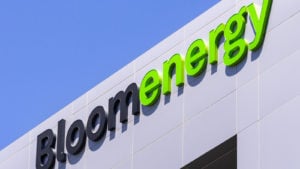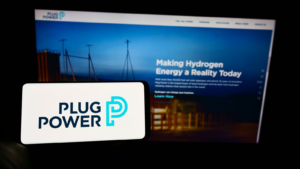
Now is a great time to be looking for hydrogen stocks to buy.
Hydrogen stocks only continue to gain momentum as the shift toward decarbonization of energy production moves forward.
Hydrogen contains roughly three times the energy of a similar amount of gasoline by weight. The combustion of hydrogen emits only water.
That simple comparison should clue readers in on the potential of hydrogen. The world is shifting away from fossil fuels despite the difficulty in doing so and finding the best hydrogen stocks to buy will help you capitalize on that.
The hydrogen generation market should grow by more than 10% on an annualized basis between 2022 and 2027.
The Rule of 72 dictates that the market for hydrogen stocks to buy should roughly double between 2022 and 2029. The opportunity is clear so let’s look at a few stocks worth considering in the sector.
Air Products & Chemicals (APD)

Air Products & Chemicals (NYSE:APD) produces a wide variety of atmospheric gases including hydrogen, which makes it one of the more diverse hydrogen stocks to buy.
The stock appears to be oversold at the moment creating an opportunity for investors. APD shares are relatively stable compared to many of the more popular pure-play offerings in the sector. That said, there’s plenty of upside in APD shares currently.
There’s roughly $45 of upside baked into Air Products & Chemicals shares based on the consensus price and prices are trending upward. The company released earnings in early August that caused prices to drop from $300 to $280 overnight.
However, it’s fairly easy to find the positive in that earnings report which provides a reasonable argument in favor of investing now.
Air Products & Chemicals expanded during the first half of the year. Although sales contracted slightly in Q2, net income improved. Further, the company increased full-year guidance at that time.
APD includes a nice dividend as well so there’s plenty to like all around for moderate investors concerned with capital preservation and upside potential.
Bloom Energy (BE)

Investors seeking hot hydrogen stocks will be well aware of Bloom Energy (NYSE:BE) by this point.
The company sells a fuel cell-based energy generation platform called Bloom Energy Server. It converts natural gas and biogas into electricity by utilizing combustion.
Fortunately for investors, Bloom Energy has been well-received based on its recent financial reports. Q2 revenues increased by 24% to $301.1 million.
The company garners most of its income through product and service sales while also receiving revenue installation charges and electricity sales.
Bloom Energy is a growth firm that is rapidly improving its business by growing while narrowing its losses.
Firm-wide losses reached $121.165 million in Q2 ‘22 narrowing to $69.06 million a year later. Bloom Energy may be perceived as a young, volatile firm but I see it as one that is rapidly maturing based on recent results.
It’s hard to argue against this being one of the better hydrogen stocks to buy on future potential in a growing field.
Linde (LIN)

Linde (NYSE:LIN), like Air Products & Chemicals, is a more mature industrial gases and chemicals firm and stock.
That means investors receive the stability of a well-established firm and one that like Air Products & Chemicals, is also expected to appreciate in value and offers strong upside.
Dividends are 0n offer, too, and LIN shares have not seen their dividend reduced since 1996, making this one of the best hydrogen stocks to buy for dividends.
Linde is arguably the best moderate choice for hydrogen investors at this point. Sales contracted slightly during the second quarter. However, Linde has weathered business cycles before and was able to increase operating margins and EPS by roughly 15% in the period.
The company also increased its EPS guidance for the remainder of 2023 further suggesting that it’s a very well-run firm.
The firm operates 80 hydrogen plants globally and more than 200 hydrogen refueling stations. Linde has built a strong infrastructural network to underpin the hydrogen economy. It’s a stable firm and investment overall.
Hyster-Yale Materials (HY)

Hyster-Yale Materials (NYSE:HY) stock represents a firm that makes lift trucks and vehicles including forklifts.
The materials handling sector has adopted hydrogen fuel cell technology faster than some other sectors making HY part of this conversation.
The firm’s fundamentals clearly speak to an opportunity for investors. Hyster-Yale Materials’ sales increased by 22% in Q2, reaching $1.1 billion. Perhaps net income turned positive in both H1 and Q2 after both periods ended in losses last year.
Hyster-Yale Materials began piloting hydrogen-powered container handler vehicles at the Port of Los Angeles late last year. It speaks to the industrial adoption of hydrogen fuel cells across industrial vehicles.
That not only creates revenue streams but also real-world testing that could result in adaptations to uses in other sectors.
HY stock is more volatile than other established firms in this article, like Linde. However, if the company can continue to maintain profitability, it will emerge as a name in the hydrogen conversation as more investors understand the industrial applicability of hydrogen.
BP (BP)

BP (NYSE:BP) stands for British Petroleum, a firm headquartered in London, the financial heart of Europe, which is known for its environmentally forward thinking.
Thus, it shouldn’t surprise investors that BP stock is invested heavily into hydrogen relative to its peers across the pond.
The argument favoring BP has less to do with its current fundamentals than it does with the long-term potential of the firm. BP’s operations have faltered in 2023 overall. That’s due to commodity cyclicality as much as anything.
Oil is volatile and nearly impossible to predict. Oil firms like BP address this issue, which tends to make their stocks volatile, by focusing on investor income. BP’s 4.2% dividend smooths the bumps so to speak.
BP provides income but also a future-forward, European outlook. The firm is building the largest blue hydrogen production plant in the U.K.
The project will include massive carbon capture operations and aims to produce over 10% of the UK government’s hydrogen target for 2030.
Plug Power (PLUG)

Plug Power (NASDAQ:PLUG) is a hydrogen stock that embodies extremes that make it very difficult to pin down. It’s very easy to either get behind the stock and just as easy to discount it for that reason.
Here’s what I mean. Plug Power is marked by some impressive stats including the fact that the company has deployed more than 60,000 hydrogen fuel cell systems for e-mobility, more than any other firm globally.
The company is also the largest buyer of liquid hydrogen and built and operates a hydrogen highway that spans the continental U.S. Assuming the hydrogen market grows as expected, it’s very difficult to argue against Plug Power.
The company’s growth trajectory currently substantiates exactly that narrative. Revenues increased by 72% to $260.18 million in the second quarter. That growth is similar to the growth the company experienced in the first half.
The issue is that Plug Power is moving farther away from profitability all the while. Net losses are growing as well and the company produces roughly $1 of losses for every dollar in sales. The upside is clear but it might make sense to wait for signs of a move toward future profitability before jumping in.
FuelCell Energy (FCEL)

FuelCell Energy (NASDAQ:FCEL) also provides fuel cell energy platforms. However, the stock represents stationary hydrogen power production. FCEL stock is also very inexpensive at $1.35.
Although the shares aren’t highly rated at this time they’re worth considering. I say that because FuelCell Energy is headed in the right direction. Revenues increased by 134% in Q2 while losses hardly grew at the same time.
That trajectory is very suggestive that the company is on the precipice of beginning to reduce its losses. If that happens it’ll be in hypergrowth mode while heading toward profitability. That can create a snowball effect with a very positive trajectory.
The company lost more than $33 million in the second quarter. However, it also boasts more than $350 million in cash so it’s not as risky as its price may suggest.
The company has ongoing projects with Toyota (NYSE:TM) and Exxon Mobil (NYSE:XOM) which lend it further credibility.
On the date of publication, Alex Sirois did not have (either directly or indirectly) any positions in the securities mentioned in this article. The opinions expressed in this article are those of the writer, subject to the InvestorPlace.com Publishing Guidelines.





